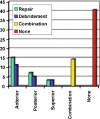Thermal shrinkage for shoulder instability
- PMID: 22754408
- PMCID: PMC3145864
- DOI: 10.1007/s11420-010-9187-7
Thermal shrinkage for shoulder instability
Abstract
Thermal capsular shrinkage was popular for the treatment of shoulder instability, despite a paucity of outcomes data in the literature defining the indications for this procedure or supporting its long-term efficacy. The purpose of this study was to perform a clinical evaluation of radiofrequency thermal capsular shrinkage for the treatment of shoulder instability, with a minimum 2-year follow-up. From 1999 to 2001, 101 consecutive patients with mild to moderate shoulder instability underwent shoulder stabilization surgery with thermal capsular shrinkage using a monopolar radiofrequency device. Follow-up included a subjective outcome questionnaire, discussion of pain, instability, and activity level. Mean follow-up was 3.3 years (range 2.0-4.7 years). The thermal capsular shrinkage procedure failed due to instability and/or pain in 31% of shoulders at a mean time of 39 months. In patients with unidirectional anterior instability and those with concomitant labral repair, the procedure proved effective. Patients with multidirectional instability had moderate success. In contrast, four of five patients with isolated posterior instability failed. Thermal capsular shrinkage has been advocated for the treatment of shoulder instability, particularly mild to moderate capsular laxity. The ease of the procedure makes it attractive. However, our retrospective review revealed an overall failure rate of 31% in 80 patients with 2-year minimum follow-up. This mid- to long-term cohort study adds to the literature lacking support for thermal capsulorrhaphy in general, particularly posterior instability.
Electronic supplementary material: The online version of this article (doi:10.1007/s11420-010-9187-7) contains supplementary material, which is available to authorized users.
Keywords: arthroscopic shoulder stabilization; outcomes; shoulder instability; thermal capsulorrhaphy.
Figures




Similar articles
-
Arthroscopic stabilization of posterior shoulder instability.Knee Surg Sports Traumatol Arthrosc. 2010 Dec;18(12):1762-6. doi: 10.1007/s00167-010-1110-8. Epub 2010 Apr 22. Knee Surg Sports Traumatol Arthrosc. 2010. PMID: 20411378
-
The effects of thermal capsular shrinkage on the outcomes of arthroscopic stabilization for primary anterior shoulder instability.Am J Sports Med. 2005 May;33(5):705-11. doi: 10.1177/0363546504270563. Epub 2005 Feb 16. Am J Sports Med. 2005. PMID: 15722277
-
Electrothermal arthroscopic shoulder capsulorrhaphy: a minimum 2-year follow-up.Am J Sports Med. 2007 Sep;35(9):1484-8. doi: 10.1177/0363546507301082. Epub 2007 Apr 24. Am J Sports Med. 2007. PMID: 17456642
-
Arthroscopic versus open Bankart repair for traumatic anterior shoulder instability.Clin Sports Med. 2000 Jan;19(1):19-48. doi: 10.1016/s0278-5919(05)70294-5. Clin Sports Med. 2000. PMID: 10652663 Review.
-
Thermal capsulorrhaphy for the treatment of shoulder instability.Am J Sports Med. 2006 Aug;34(8):1356-63. doi: 10.1177/0363546506287824. Epub 2006 May 9. Am J Sports Med. 2006. PMID: 16685091 Review.
Cited by
-
Early Outcomes Following Plantar Condylectomy and Imbrication of Plantar Plate to Metatarsal Neck for Metatarsalgia and Grade 0 Lesser Toe Metatarsophalangeal Joint Instability.Foot Ankle Orthop. 2023 Dec 7;8(4):24730114231213615. doi: 10.1177/24730114231213615. eCollection 2023 Oct. Foot Ankle Orthop. 2023. PMID: 38074524 Free PMC article.
-
Arthroscopic Posterior Labral Repair and Capsular Closure via Single Working Portal for Posterior Shoulder Instability.Arthrosc Tech. 2022 Aug 6;11(9):e1557-e1561. doi: 10.1016/j.eats.2022.04.007. eCollection 2022 Sep. Arthrosc Tech. 2022. PMID: 36185126 Free PMC article.
-
Arthroscopic Soft Tissue Procedures for Anterior Shoulder Instability.Open Orthop J. 2017 Aug 31;11:979-988. doi: 10.2174/1874325001711010979. eCollection 2017. Open Orthop J. 2017. PMID: 29114337 Free PMC article.
-
History of surgical stabilization for posterior shoulder instability.JSES Open Access. 2019 Nov 15;3(4):350-356. doi: 10.1016/j.jses.2019.08.008. eCollection 2019 Dec. JSES Open Access. 2019. PMID: 31891038 Free PMC article. Review.
-
Scapholunate Ligament Injuries.J Hand Surg Glob Online. 2024 Apr 1;6(3):245-267. doi: 10.1016/j.jhsg.2024.01.015. eCollection 2024 May. J Hand Surg Glob Online. 2024. PMID: 38817761 Free PMC article. Review.
References
-
- Andrews JR, Dugas JR. Diagnosis and treatment of shoulder injuries in the throwing athlete: the role of thermal-assisted capsular shrinkage. Instr Course Lect. 2001;50:17–21. - PubMed
LinkOut - more resources
Full Text Sources
Molecular Biology Databases

